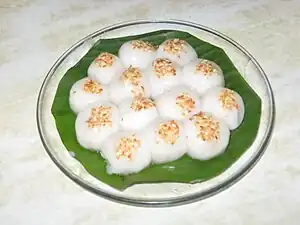Tết Hàn Thực
Tết Hàn Thực (chữ Hán: 節寒食) or Tết bánh trôi bánh chay, is a Vietnamese holiday celebrated on the 3rd day of the 3rd lunar month. Hàn Thực means cold food.
| Tết Hàn Thực | |
|---|---|
 Bánh trôi - the typical dish of this holiday | |
| Official name | Tết Hàn Thực (節寒食) Tết bánh trôi bánh chay |
| Observed by | Vietnamese |
| Celebrations | make bánh trôi and bánh chay to worship ancestors |
| Date | on the third day of the third lunar month |
| Related to | Cold Food Festival Hanshik |
Origins
In Vietnam, the third day of the third lunar month celebrates Tết Hàn Thực "imitating the Northern [Chinese] people, celebrating the day Jie Zhitui died in flames".[1]The two words "Hàn thực" are associated with a classic reference in China, which is well known through the novel Chronicles of the Eastern Zhou Kingdoms.
During the Spring and Autumn period, Duke Wen of Jin of the Jin state encountered a riot, had to leave the country in exile, and met a sage named Jie Zhitui to help him. Later, Duke Wen of Jin returned to be the duke, conferred rewards for those who had merit, but forgot about Jie Zhitui. Jie Zhitui did not hold any grudges, went home and took his mother to the mountains to hide. Duke Wen of Jin remembered, let people find. Because Jie Zhitui refused to accept the reward, Duke Wen of Jin ordered the forest to be burned to force him out; in the end, both his mother and his were burned to death. The duke had mercy, built a temple and ordered a three-day abstinence from burning fire, only eating cold food that was cooked to commemorate.[2]
Traditions
Eat bánh trôi, bánh chay

In Vietnam today, people only make bánh trôi or bánh chay to replace cold foods, but only worship ancestors, and have little connection to Jie Zhitui and other taboos.[3] On this day, Vietnamese people often "make bánh trôi, arrange banquets, worship ancestors",[1] so bánh trôi are also called real bánh Hàn thực.[4]
According to researcher Trần Quang Đức, the custom of eating bánh trôi on Tết Hàn Thực in Vietnam was likely introduced in the Lê dynasty, prevalent in the Revival Lê - Nguyễn period. In 1773, Lê Quý Đôn said: "Our country's custom is that the cake is the most important, every year on the third day of the third [lunar] month, it is made. Northerners [Chinese people] also have it, called the Thủy đoàn".[5] According to the explanation of Chỉ nam ngọc âm giải nghĩa (written around the 16th century of the Lê dynasty) explained: "[Bánh] Trôi nước has the art name of the Thủy đoàn, the inside is the sugar, the outside is the powder that floats into a floating ball."
Eat bánh cuốn

According to the records of Lê Tắc, the people of the Trần dynasty "Tiết Hàn Thực, give each other bánh cuốn". Through the poem Tặng bánh xuân cho ngài thiên sứ Trương Hiển Khanh, made in 1291, Trần Nhân Tông wrote: "Today is the third day of the third [lunar] month, on a tray carved with red clouds, displaying bánh Xuân Thái, here is the old custom of ancient Annam."[6] According to Chỉ nam ngọc âm giải nghĩa, bánh Xuân Thái is also another name for bánh cuốn.[7]
See also
References
- "Tiểu học Bản quốc phong tục sách" (also called "An Nam phong tục sách")
- Vũ, Phượng. "Tết Hàn Thực, tiết Thanh Minh: Nguồn gốc và ý nghĩa việc cúng bánh trôi, bánh chay". Thanh Niên.
- Việt Nam phong tục, Phan Kế Bính, Nhà xuất bản Thành phố Hồ Chí Minh, 2004
- The poem "Bánh trôi nước" by Hồ Xuân Hương, in "Tạp thảo tập" and "Xuân Hương thi sao" is copied with the name "Vịnh Hàn thực bính" (Vịnh bánh Hàn thực)
- Vân đài loại ngữ
- Kiều, Thu Hoạch (2004). Tinh tuyển văn học Việt Nam. Khoa học xã hội. p. 579.
- "Ngoài bánh trôi bánh chay, Tết Hàn thực ngày xưa ông bà ta còn ăn một loại bánh khác đấy!". kenh14.vn.